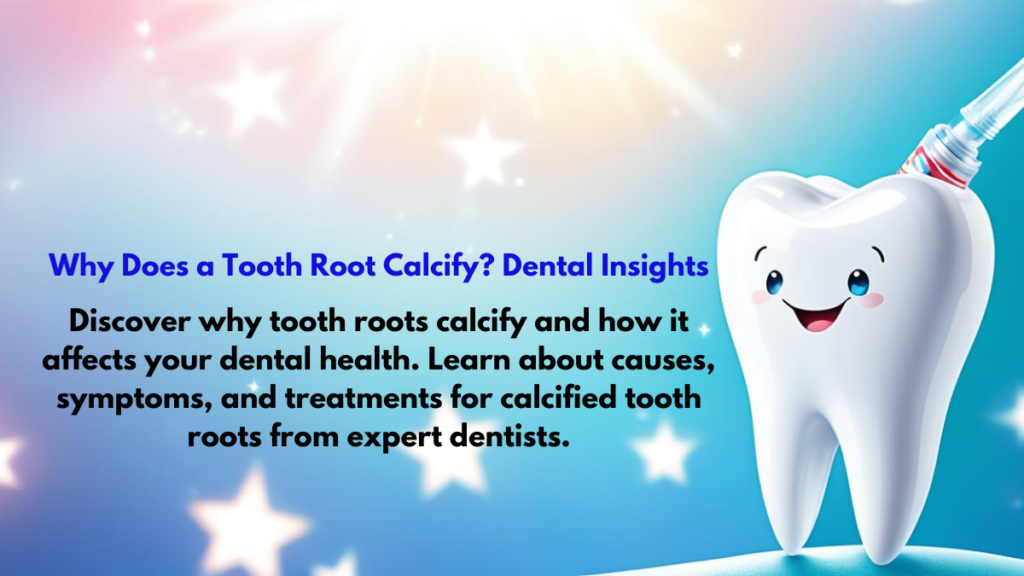Ever wondered why a tooth root can calcify? It’s a common issue that affects dental health. As an endodontist in Midtown Manhattan, I’ve seen many cases. In this article, we’ll explore why does a tooth root calcify and discuss the latest ways to manage it effectively.
Understanding why does a tooth root calcify can help endodontists deal with tough cases, like when pulp chambers and root canals are blocked by hard tissue buildup. Knowing the causes of this condition improves treatment and helps maintain long-term dental health.
Understanding Tooth Calcification and Its Causes
Calcified root canals happen when the space inside a tooth becomes blocked. This can be due to many reasons, like aging, injury, or health issues. It’s a tough problem for dentists to fix.
Biological Factors Leading to Pulpal Calcification
As we get older, our teeth change, and sometimes, hard tissue builds up. This makes the canal inside the tooth smaller. Over time, this buildup makes it hard for dentists to treat the tooth.
Impact of Systemic Health Conditions on Dental Pulp
Some health issues can also cause tooth roots to calcify. For example, pulpitis, a long-term inflammation of the pulp, speeds up this process. It makes the canal smaller, making root canal treatments harder.
How Lifestyle Choices Contribute to Tooth Root Calcification
Lifestyle choices can also lead to calcified tooth roots. For instance, injuries from sports can start the calcification process. Also, if a tooth decays for a long time, it can shrink the pulp, making infections more likely and treatment harder.
| Factors Contributing to Tooth Calcification | Impact |
|---|---|
| Aging | Gradual buildup of hard tissue in the pulp chamber, narrowing the canal space |
| Dental Trauma | Trigger for the calcification process, complicating dental treatment |
| Chronic Dental Conditions (e.g., Pulpitis) | Accelerate the calcification process, leading to narrowed canal space |
| Longstanding Tooth Decay | Shrinking of the pulp in the tooth’s canal, increasing the risk of infection and the need for calcified root canal treatment |
Exploring the Symptoms of Calcified Tooth Roots
Dealing with calcified root canals requires a skilled endodontist. These experts are trained to handle the tough challenges of calcified canals. They use advanced tools and techniques. They also use high-resolution imaging like cone beam computed tomography (CBCT) for detailed 3D views of the tooth’s inside.
Patients with calcified tooth roots may notice several symptoms, including:
- calcified tooth symptoms: It’s hard to access and find the root canal because it’s hardened.
- pain after calcified root canal: You might feel pain or discomfort after a root canal because it’s hard to clean and seal the calcified canal.
- what happens if one calcified root is left after root canal: Leaving a calcified root untreated can cause ongoing infection, swelling, and might even mean losing the tooth.
To tackle these issues, endodontists use special tools. These include flexible nickel-titanium rotary files and ultrasonic devices. These tools help them clean and shape the canal system better. This makes treatment more likely to work.
| Symptom | Description |
|---|---|
| Calcified Tooth Symptoms | It’s hard to access and find the root canal because it’s hardened. |
| Pain After Calcified Root Canal | You might feel pain or discomfort after a root canal because it’s hard to clean and seal the calcified canal. |
| What Happens if One Calcified Root is Left After Root Canal | If a calcified root is left untreated, it can lead to ongoing infection, swelling, and might even mean losing the tooth. |
Why Does a Tooth Root Calcify? Analyzing the Underlying Mechanisms
The process of tooth root calcification is complex and influenced by many factors. It’s important to understand these factors for proper diagnosis and treatment.
The Role of Age and Dental Trauma in Calcification
Age is a big factor in tooth root calcification. As we get older, the dental pulp inside the tooth starts to mineralize. This leads to the formation of hard deposits called pulp stones or denticles. This change is common and affects many people.
Dental trauma, like injuries to the teeth, can also cause calcification. When the body reacts to trauma, it can put calcium salts in the pulp. This can narrow or block the root canal space.
The Correlation Between Dental Procedures and Calcification
Some dental procedures can lead to tooth root calcification. For example, fillings or crowns can change the pulp and cause calcified deposits. Orthodontic treatments, which move teeth, can also increase pulp calcification in some cases.
A skilled Endodontist in Midtown Manhattan is key for dealing with calcified root canals. They use advanced techniques and tools to overcome the challenges of a narrowed or blocked canal.
| Factors Influencing Tooth Root Calcification | Prevalence Rates |
|---|---|
| Age | Increases with age, up to 90% in older individuals |
| Dental Trauma | Pulp canal obliteration in 69-73% of affected incisors |
| Dental Restorations | Localized calcification in some cases |
| Orthodontic Treatment | Increased pulp calcification in certain cases |
Preventive Measures and Treatment Options for Calcified Root Canals
Dealing with calcified root canals is tough for dental pros, but there are ways to tackle it. Keeping your mouth clean, going for regular dental check-ups, and fixing dental problems fast can lower the risk of pulp calcification. Eating right and drinking enough water also helps keep your dental pulp healthy.
Endodontists use special tools and methods to work on calcified root canals. Tools like flexible nickel-titanium files and ultrasonic devices make cleaning and shaping the canal easier. They also use advanced scans like cone beam computed tomography (CBCT) to see the tooth’s structure clearly. This helps them find and treat the calcified canals accurately.
Research shows that dynamic navigation systems (DNS) are better at finding these hard-to-reach canals. They also remove less of the tooth structure than traditional methods. Plus, 3D printing technology helps make guides for accessing severely calcified areas safely.
| Preventive Measures | Treatment Options |
|---|---|
| Maintaining good oral hygieneRegular dental check-upsPrompt treatment of dental issuesBalanced diet and proper hydration | Flexible nickel-titanium rotary filesUltrasonic devicesCone beam computed tomography (CBCT) imagingDynamic navigation systems (DNS)3D printed customized guides |
By using these preventive steps and advanced treatments, endodontists can overcome the challenges of calcified root canals. This approach helps ensure successful treatments and keeps your natural teeth intact.
Technological Advances in Diagnosing and Managing Calcified Canals
Dental professionals are always looking for the best ways to treat root canals. New technologies have changed how we handle calcified root canals. Using ultrasonic tools is now a key part of this process.
Benefits of Ultrasonic Instruments in Endodontic Treatment
Ultrasonic files and tips use high-frequency vibrations. These vibrations help break up and remove hard deposits from the canal walls. This makes it easier to clean and treat the canals, lowering the risk of complications.
How Microscopes Revolutionize the Approach to Calcified Chambers
Using an operating microscope has changed endodontic care a lot. The microscope lets dentists see the calcified chamber clearly. This means they can clean and disinfect better, and avoid mistakes.
Getting the right equipment for treating calcified root canals costs more than $150,000. But, the benefits are huge. Technologies like microscopes and ultrasonic tools make diagnosing and treating calcified canals much better. This leads to better results for patients.
Conclusion
Treating calcified root canals needs advanced tech, special tools, and expert skills. An Endodontist in Midtown Manhattan, like Dr. Iofin at Fifth Avenue Endodontic, has the experience and uses the latest methods for these tough cases. They help patients make smart choices about their dental care.
Knowing how to treat calcified root canals is crucial. An experienced endodontist is essential for handling these complex cases well.
If you have questions or need a consultation, contact Fifth Avenue Endodontic. Dr. Iofin and his team offer full care and support for your dental health. This includes help with calcification teeth, calcified root canal, and root canal calcification issues.
Endodontists use the latest tech, like cone-beam computed tomography (CBCT) and radiopaque gutta-percha markers. This helps them diagnose and treat even the most untreated calcified canal cases well. It leads to the best outcomes for patients, preventing more problems and protecting their dental health.
FAQ
Why does a tooth root calcify?
Tooth root calcification happens when the pulp chamber and root canals get blocked. This blockage is often due to aging, dental injuries, or diseases.
What are the causes of tooth calcification?
Aging, health issues, and lifestyle choices can lead to tooth root calcification. Over time, calcium salts and minerals build up, narrowing the canal. This makes it hard for endodontists to treat.
What are the symptoms of a calcified tooth root?
A calcified tooth root can cause pain, especially after a root canal. It may also make treating the tooth fully impossible if one calcified root is missed.
How do dental procedures impact tooth root calcification?
Dental procedures, like previous root canal treatments, can speed up calcification. This makes treating the tooth again harder in the future.
How can calcified root canals be treated?
Expert endodontists use new techniques and tools to clean and treat calcified root canals. This includes high-resolution imaging and specialized instruments. It helps increase the success rate of treatment.
What role do modern technologies play in managing calcified canals?
Technologies like CBCT imaging, ultrasonic tools, and dental microscopes are key. They help endodontists diagnose and treat calcified root canals accurately.


